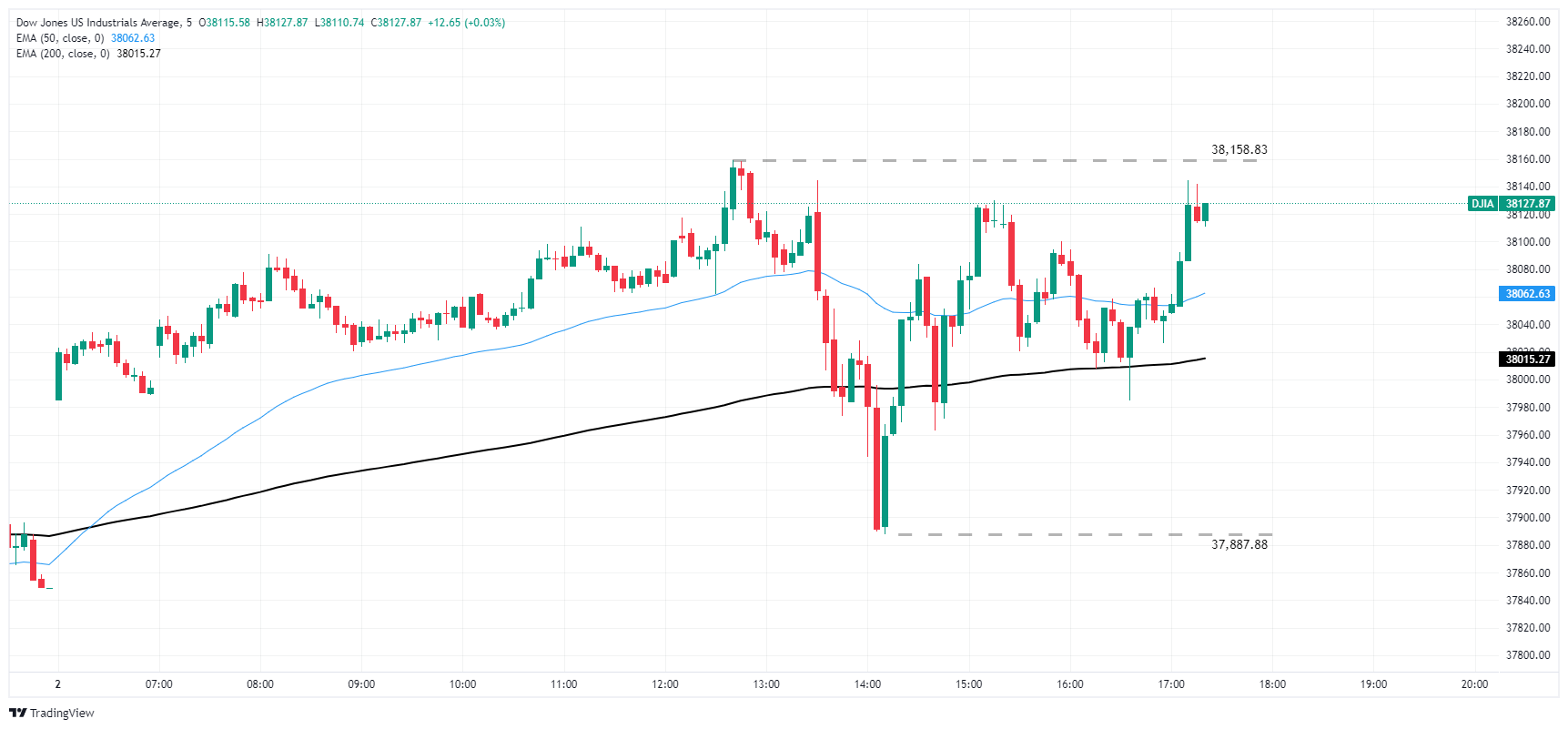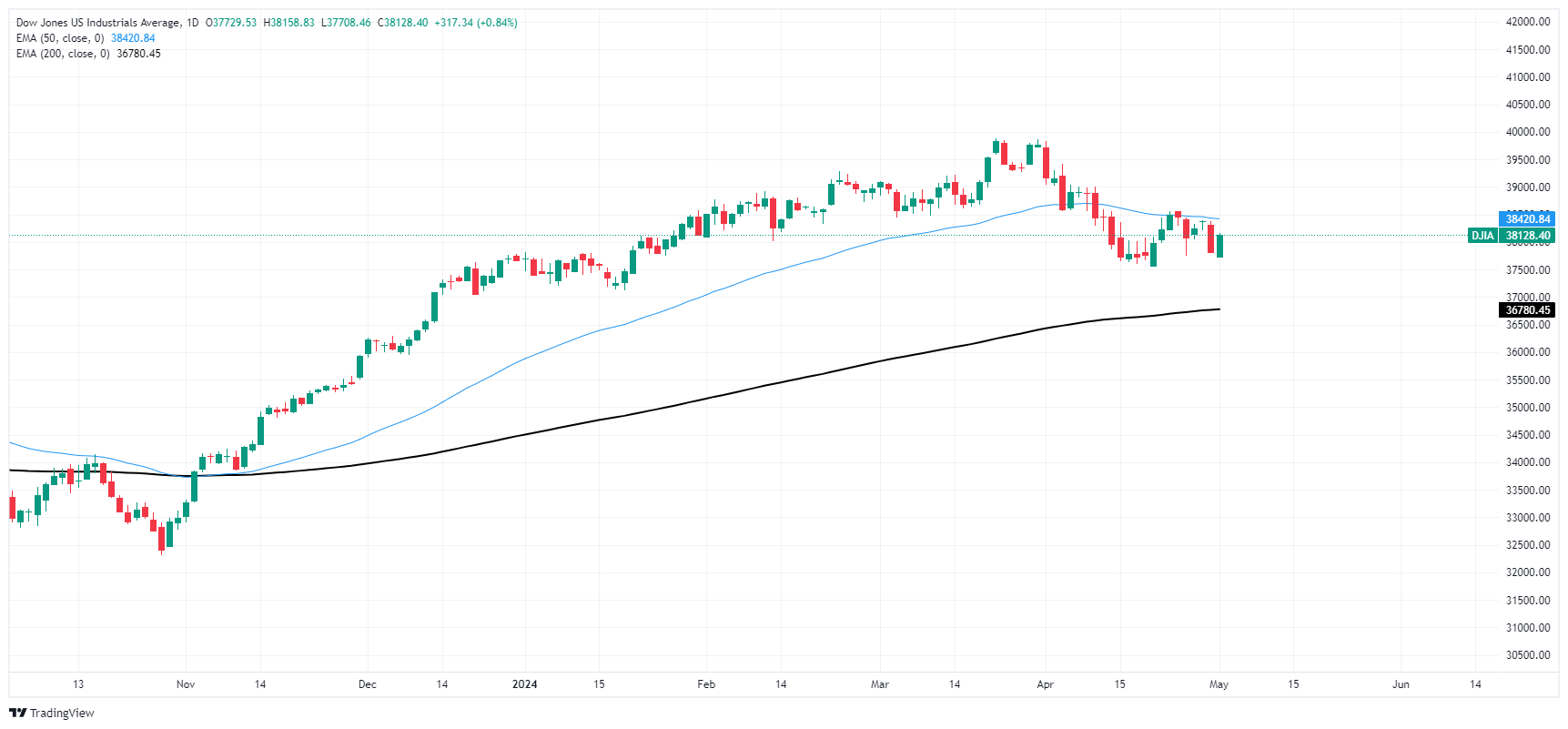- Phân tích
- Tin tức và các công cụ
- Tin tức thị trường
- Dow Jones Industrial Average claws higher but risk appetite weighed down by rate expectations
Dow Jones Industrial Average claws higher but risk appetite weighed down by rate expectations
- Dow Jones recovers 38,000.00 in thin bullish momentum.
- Market expectations for Fed rate cuts are widening.
- Friday’s NFP labor figure to be a key print for rate watchers.
The Dow Jones Industrial Average (DJIA) is up around four-tenths of a percent on Thursday as equity markets grapple with a choppy recovery following a plunge earlier this week. Earnings season is helping to bolster securities that have efficiently bolstered their ratios, and investors are grappling with when to expect a first rate cut from the Federal Reserve (Fed), with a cut in 2024 assumed to be a foregone conclusion.
Wall Street expectations of when and how often the Fed will cut rates are beginning to widen out as investors grapple with a complicated US economic landscape. S&P Global has reduced their Fed outlook to a single quarter-point cut in December, while some investment banks are forecasting as many as four 25-basis-point cuts through the rest of the year beginning as soon as July.
At current cut, the CME’s FedWatch Tool shows rate markets are expecting a first cut from the Fed at the Federal Open Market Committee’s (FOMC) September meeting. Rate markets are giving 40% odds of no cut in September, with 70% odds of at least 25 basis points in cuts by November.
Dow Jones news
Around two-thirds of the securities that comprise the Dow Jones Industrial Average are underwater on Thursday, with 3M Co. (MMM) leading the charge lower, falling 1.4% to $97.08 per share. The topside leaders include megacap names Boeing Co. (BA), Amazon.com Inc (AMZN), and Apple Inc. (AAPL). Boeing rose 3.4% to $177.31 per share, with Amazon climbing 2.45% and Apple gaining around 2%.
Dow Jones technical outlook
The DJIA found a midday high of 38,158.83 on Thursday, with a quick tumble to 37,887.88 as investor risk appetite keeps one foot out of the door. Equities have recovered into the high end, but topside momentum remains thin as the Dow Jones churns in familiar territory close to the 38,000.00 handle.
The Dow Jones is recovering into near-term consolidation, but the index is struggling to develop bullish legs after a near-term decline below 37,600.00. The major equity index is trading well above the 200-day Exponential Moving Average (EMA) at 36,780.52, but the DJIA remains down 4.3% from record highs at the last peak of 39,887.49.
Dow Jones five-minute chart
Dow Jones daily chart
Dow Jones FAQs
The Dow Jones Industrial Average, one of the oldest stock market indices in the world, is compiled of the 30 most traded stocks in the US. The index is price-weighted rather than weighted by capitalization. It is calculated by summing the prices of the constituent stocks and dividing them by a factor, currently 0.152. The index was founded by Charles Dow, who also founded the Wall Street Journal. In later years it has been criticized for not being broadly representative enough because it only tracks 30 conglomerates, unlike broader indices such as the S&P 500.
Many different factors drive the Dow Jones Industrial Average (DJIA). The aggregate performance of the component companies revealed in quarterly company earnings reports is the main one. US and global macroeconomic data also contributes as it impacts on investor sentiment. The level of interest rates, set by the Federal Reserve (Fed), also influences the DJIA as it affects the cost of credit, on which many corporations are heavily reliant. Therefore, inflation can be a major driver as well as other metrics which impact the Fed decisions.
Dow Theory is a method for identifying the primary trend of the stock market developed by Charles Dow. A key step is to compare the direction of the Dow Jones Industrial Average (DJIA) and the Dow Jones Transportation Average (DJTA) and only follow trends where both are moving in the same direction. Volume is a confirmatory criteria. The theory uses elements of peak and trough analysis. Dow’s theory posits three trend phases: accumulation, when smart money starts buying or selling; public participation, when the wider public joins in; and distribution, when the smart money exits.
There are a number of ways to trade the DJIA. One is to use ETFs which allow investors to trade the DJIA as a single security, rather than having to buy shares in all 30 constituent companies. A leading example is the SPDR Dow Jones Industrial Average ETF (DIA). DJIA futures contracts enable traders to speculate on the future value of the index and Options provide the right, but not the obligation, to buy or sell the index at a predetermined price in the future. Mutual funds enable investors to buy a share of a diversified portfolio of DJIA stocks thus providing exposure to the overall index.
© 2000-2024. Bản quyền Teletrade.
Trang web này được quản lý bởi Teletrade D.J. LLC 2351 LLC 2022 (Euro House, Richmond Hill Road, Kingstown, VC0100, St. Vincent and the Grenadines).
Thông tin trên trang web không phải là cơ sở để đưa ra quyết định đầu tư và chỉ được cung cấp cho mục đích làm quen.
Giao dịch trên thị trường tài chính (đặc biệt là giao dịch sử dụng các công cụ biên) mở ra những cơ hội lớn và tạo điều kiện cho các nhà đầu tư sẵn sàng mạo hiểm để thu lợi nhuận, tuy nhiên nó mang trong mình nguy cơ rủi ro khá cao. Chính vì vậy trước khi tiến hành giao dịch cần phải xem xét mọi mặt vấn đề chấp nhận tiến hành giao dịch cụ thể xét theo quan điểm của nguồn lực tài chính sẵn có và mức độ am hiểu thị trường tài chính.
Sử dụng thông tin: sử dụng toàn bộ hay riêng biệt các dữ liệu trên trang web của công ty TeleTrade như một nguồn cung cấp thông tin nhất định. Việc sử dụng tư liệu từ trang web cần kèm theo liên kết đến trang teletrade.vn. Việc tự động thu thập số liệu cũng như thông tin từ trang web TeleTrade đều không được phép.
Xin vui lòng liên hệ với pr@teletrade.global nếu có câu hỏi.















